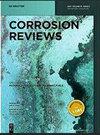Using a reverse life plot for estimating fatigue endurance/limit
IF 2.7
4区 材料科学
Q3 ELECTROCHEMISTRY
引用次数: 0
Abstract
This short review paper describes the use of a reverse life plot, σ a versus 1/N f , for estimating a fatigue endurance/limit, σ FL. The method is applicable for different alloy-environment systems and load R-ratios. Due to inherent scatter in the fatigue data approaching fatigue limit, a ‘staircase’ method is often utilized that requires relatively large number of specimens (around 15–30) to be tested just for fatigue endurance/limit determination alone. The proposed method uses only high-cycle-fatigue (HCF) S-N data. The estimated fatigue endurance/limit is verified against the data from staircase method for 7000 Al alloy in air and corrosive 0.5 % NaCl solution environment. The comparison with the staircase method shows fairly good agreement. An additional example shows how this method estimates endurance limits for 4140 steels tested in three environments: dry air, air with 93 % RH, and aerated 3 % NaCl solution.使用反向寿命图估算疲劳耐久性/极限值
这篇简短的综述论文介绍了使用反向寿命图,即 σ a 与 1/N f 的关系,来估算疲劳耐久性/极限值 σ FL。该方法适用于不同的合金环境系统和负载 R 比。由于接近疲劳极限的疲劳数据存在固有的分散性,通常采用 "阶梯 "法,仅为确定疲劳耐久性/极限就需要测试相对较多的试样(约 15-30 个)。建议的方法只使用高循环疲劳(HCF)S-N 数据。针对空气和腐蚀性 0.5 % NaCl 溶液环境中的 7000 Al 合金,根据阶梯法数据对估计的疲劳耐久性/极限进行了验证。与阶梯法的比较结果显示两者的一致性相当好。另一个例子显示了该方法如何估算 4140 钢在三种环境下测试的耐久极限:干燥空气、93% 相对湿度的空气和通气的 3% 氯化钠溶液。
本文章由计算机程序翻译,如有差异,请以英文原文为准。
求助全文
约1分钟内获得全文
求助全文
来源期刊

Corrosion Reviews
工程技术-材料科学:膜
CiteScore
5.20
自引率
3.10%
发文量
44
审稿时长
4.5 months
期刊介绍:
Corrosion Reviews is an international bimonthly journal devoted to critical reviews and, to a lesser extent, outstanding original articles that are key to advancing the understanding and application of corrosion science and engineering in the service of society. Papers may be of a theoretical, experimental or practical nature, provided that they make a significant contribution to knowledge in the field.
 求助内容:
求助内容: 应助结果提醒方式:
应助结果提醒方式:


